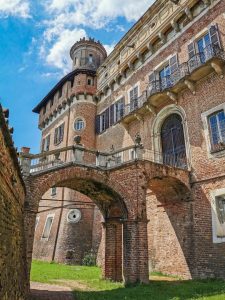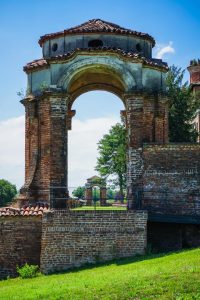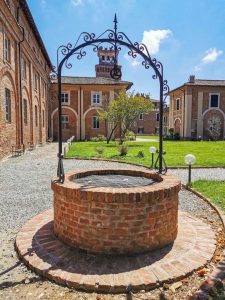
Lombardy Hidden Gems: The Castle Of Chignolo A short hop from Milan, Chignolo Po is a quaint village with a lovely castle that’s considered one of Lombardy’s best-kept secrets.
Today I take you to one of my favorite Lombardy hidden gems, the lovely Castle of Chignolo Po, a quaint village that you can easily visit as a half-day trip from Milan.The range of tourist attractions in Lombardy is truly endless, from historic landmarks to charming towns and picturesque lakes. And then there are those precious hidden gems that are rarely mentioned among the must-see sights but offer a fabulous, crowd-free experience.
One of these is the Castle of Chignolo Po, one of Lombardy’s most magnificent residential castles. It’s a grandiose estate immersed in the countryside around Pavia, just south of Milan, with a long history that spans centuries.
This castle makes for a pleasant trip from Milan and Pavia, but it’s also regarded as a top wedding destination in Lombardy (by the way, in this article you’ll find more day trip ideas from Milan).
The history of the castle
The history of the Castle of Chignolo Po started in 740 when Pavia was the capital of the Lombards. At that time, King Liutprand erected a defensive tower to control a long stretch of land around the Po River and the ancient Via Francigena, connecting Northern Europe with Rome. This tower can still be seen today and constitutes the oldest core of the castle.
The fortress was later donated to the Benedictine monks of the Abbey of Saint Cristina and became one of the most important shelters along the Via Francigena route. Actually, it was designated as the 40th station along the Via Francigena route by the Archbishop of Canterbury, Sigeric the Serious, who visited the complex in 990 on his way back to Canterbury from the Vatican, where he had been officially ordained.
During the 13th century, the fortress became one of the most important Lombard fiefdoms under the Pusterla family, which was then followed by the Federici and the Cusani. These noble families gradually transformed the fortress into an elegant castle. Most of the merit goes to Cardinal Agostino Cusani, the Pope’s Ambassador to the Republic of Venice and to the Court of Louis XIV in Paris, who hired the roman baroque architect Giovanni Ruggeri along with Venetian artists of the Tiepolesque school. They build gardens, statues, fountains, as well as elaborate stuccos and frescoes.
The cardinal also commissioned the construction of a hunting lodge in the heart of the park, as a place of leisure and entertainment for guests. Fun fact: he got the idea from King Vittorio Amedeo II of Savoy, who was building the Stupinigi Royal Hunting Residence precisely in those years.
The result was a grandiose, refined castle that someone dubbed “the Versailles of Lombardy”. Ok, maybe the comparison is a bit exaggerated, but it’s undoubtedly a fabulous complex to visit. Also, numerous popes, kings, and emperors visited the castle throughout the years, including the Austrian Emperor Francesco I and Napoleon.
In 1936, the last descendant of the Cusani family left the castle to the Sovereign Order of Malta, who used it as their representative office until 1987, when they sold it to the Procaccini family. Today the complex, known also as Procaccini Castle, is a private residence. The Procaccini’s restored the estate with great respect for its historic heritage and opened it to the public.
What to see at the Castle of Chignolo Po
You can visit the Castle of Chignolo Po with a guided tour that you can easily book on the castle’s official website. Our guide, Roberto, was extremely knowledgeable and shared tones of interesting details about the history of the castle. The tour lasted about one hour and a half and there was never a dull moment.
Bear in mind that it’s not possible to see all the rooms inside the castle, as this is a private residence. For the same reason, taking pictures of the interiors is not allowed, so you’ll have to go and see for yourself most of what I’m about to describe!
First, the guide took us on a tour of the expansive park to admire the lovely statues and the magnificent exteriors of the castle. The main gated entrance visible from the village is absolutely gorgeous, while the curved staircase oozes elegance and charm. We also saw what remains of the hunting lodge I mentioned earlier, which certainly saw better times and would require some renovation works.
Then we slowly made our way inside the ancient wine cellar and the historic kitchen with the original utensils that document what daily life was like at the castle. I could almost see the cooks busy preparing the banquet to celebrate the arrival of Emperor Francesco I at the castle back in 1825!
Overall, the castle interiors are really well preserved. We passed through a scenic Baroque courtyard with porticoes and a delightful balcony to reach the rooms located on the upper floors. Each salon we visited is uniquely decorated with statues and paintings, while ceilings boast splendid frescoes with curious three-dimensional elements.
The ballroom, for example, features a series of frescoes representing the four seasons, as well as false windows with reference to the colonies in the form of a caged parrot. Particularly beautiful is the room of Pope Clemente XI, who was often a guest at the castle, which boasts beautiful 15th-century flooring and remarkably beautiful stuccos.The castle still preserves the room where Napoleon Bonaparte used to sleep during a battle that took place near Chignolo Po. Unfortunately, though, it was not possible to see it during the tour.The final part of the tour took us to the beautiful library stuffed with many of the 10,000 books scattered around the castle, and a tiny chapel on the ground floor.










